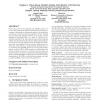ACSAC
2005
IEEE
14 years 5 months ago
2005
IEEE
Fine-grained and expressive access control policies on application resources need to be enforced in applicationlevel code. Uniformly enforcing a single policy (referred to as the ...
OTM
2007
Springer
14 years 6 months ago
2007
Springer
The WS-Policy framework has been introduced to allow policy to be expressed and associated with Web Services thereby enabling organizations to manage the quality of their services...
CPAIOR
2007
Springer
14 years 6 months ago
2007
Springer
One of the most important policies adopted in inventory control is the (R,S) policy (also known as the “replenishment cycle” policy). Under the non-stationary demand assumption...
CCS
2007
ACM
14 years 6 months ago
2007
ACM
In defining large, complex access control policies, one would like to compose sub-policies, perhaps authored by different organizations, into a single global policy. Existing po...
NDSS
2007
IEEE
14 years 6 months ago
2007
IEEE
With Hidden Credentials Alice can send policyencrypted data to Bob in such a way that he can decrypt the data only with the right combination of credentials. Alice gains no knowle...
ICNP
2007
IEEE
14 years 6 months ago
2007
IEEE
A firewall policy that is correct and complete is crucial to the safety of a computer network. An adversary will benefit a lot from knowing the policy or its semantics. In this pap...
IAT
2007
IEEE
14 years 6 months ago
2007
IEEE
Policy making is a multi-actor process: it involves a variety of actors, each trying to further their own interests. How these actors decide and act largely depends on the way the...
ASWEC
2008
IEEE
14 years 6 months ago
2008
IEEE
Policy based management in Service Oriented Architecture (SOA) allows organizations to apply rules and regulations on their business processes. Policy has long been employed in th...
SIGCOMM
2009
ACM
14 years 6 months ago
2009
ACM
We define some interesting incentive issues that arise in the management of virtual infrastructures. We demonstrate that participants’ decisions about the quantities of infrast...
SACMAT
2009
ACM
14 years 6 months ago
2009
ACM
Many access control policy languages, e.g., XACML, allow a policy to contain multiple sub-policies, and the result of the policy on a request is determined by combining the result...



